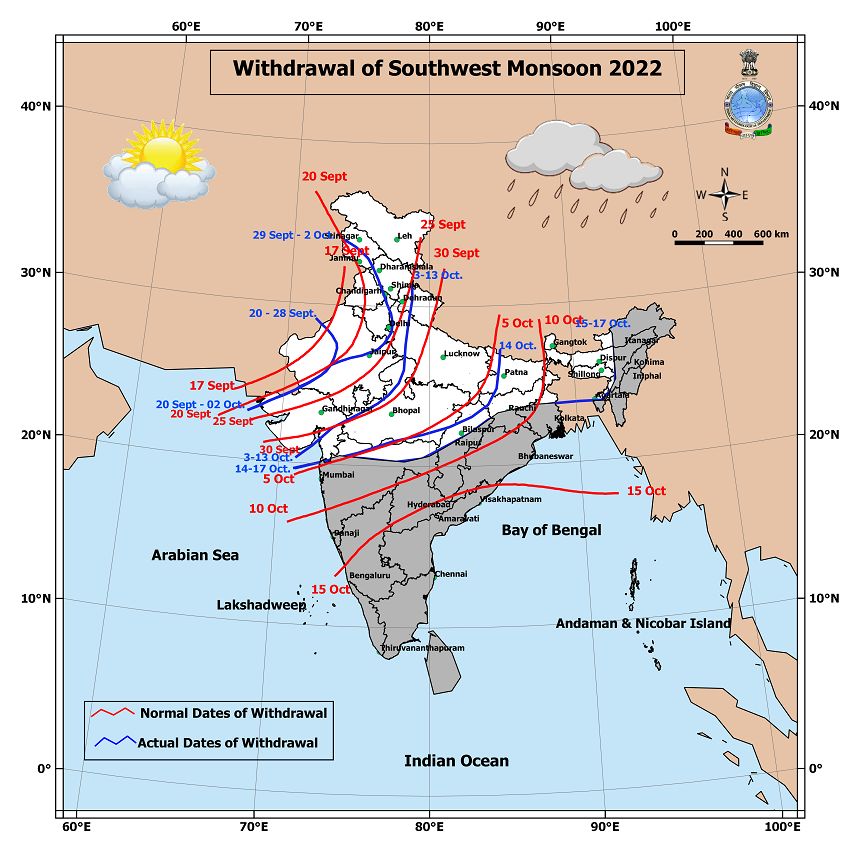Physical Address
23,24,25 & 26, 2nd Floor, Software Technology Park India, Opp: Garware Stadium,MIDC, Chikalthana, Aurangabad, Maharashtra – 431001 India
Physical Address
23,24,25 & 26, 2nd Floor, Software Technology Park India, Opp: Garware Stadium,MIDC, Chikalthana, Aurangabad, Maharashtra – 431001 India

For many states of India this year, ‘October’ seems like a month right in the middle of the Indian monsoon season. It can easily pass off as ‘June’ or even ‘July’. Officially monsoon season has come to an end in India on September 30 and monsoon withdrawal has begun. Even withdrawal should have been completed more or less by October 15, officially. While some amount of rainfall is not unusual as part of the retreating monsoon, data shows that this has not been the case and an unprecedented amount of precipitation has taken place in many parts of the country this year in October. This has been a growing trend over the last few years.
An Extended Monsoon
Continuing a trend that has been witnessed in the last three-four years, monsoon withdrawal has got significantly delayed in many parts of the country this year as well. In 2020, complete monsoon withdrawal was announced on October 28 making it the second most delayed monsoon exit from India since 1975. In 2021, monsoon withdrawal from the entire country was announced on October 25 which made it the seventh most delayed withdrawal in the 1975-2021 time period.
“Increasing October rains have been observed for quite some time now. We came to know about large amount of rainfall occurring in Assam and other parts of Northeast India (NEI) towards the end of September and in the month of October at the beginning of the new millennium. We learned about this from instrumental records as well as anecdotal information received from local people during our field research in many parts of the northeast region(NER), where rain gauges were not there for recording and monitoring rainfall,” said Dr Partha Jyoti Das, Senior Climate-Environmental Scientist and the head of the ‘Water, Climate and Hazard Division’ of Aaranyak.
“The impact of large rainfall events happening in the month of October became prominently evident in the year 2004 when we experienced several episodes of devastating floods in Southern, Central and Western Assam. In 2008, we saw flash floods in Arunachal Pradesh and Assam in the last week of October. The year 2012 saw a repetition of this phenomenon with large parts of Western Assam receiving floods till mid-October following significant rainfall. The same was the experience in 2020 and now in 2022. Many places in the NER are reporting more than normal rainfall in the month of October,” Dr Das further added.
According to IMD, 80% excess rainfall occurred in the first ten days of the ‘post-monsoon’ season (Oct 1 to Oct 10) in the country and Northwest India witnessed 405% excess rainfall during this period. According to reports, Delhi recorded 625% (63.8mm against a normal of 8.8mm), Haryana 577%, Uttarakhand 538%, and Uttar Pradesh 698% excess rainfall in the first 10 days of October.
This is happening at a time when the IMD had officially announced the end of the monsoon season on September 30 and monsoon withdrawal from Punjab, Chandigarh, Delhi, parts of Jammu & Kashmir, Himachal Pradesh, Uttar Pradesh, Haryana, and Rajasthan.

It is important to note here that the IMD has already revised monsoon onset and withdrawal dates in 2020 keeping in mind the changing climate in the region which has definitely left an impact on the southwest monsoon. They were delayed by three to seven days in parts of central, west, east India and by a week to two weeks in northwest India. Even new withdrawal dates seem to have been transcended by the continued late withdrawal of the monsoon.
According to Skymet Weather Services, monsoon withdrawal is likely to be extended and go on till the 3rd week of October this year. IMD has said that the rain will continue even after the monsoon and the average rainfall in India during October is likely to be above normal at 115%. These events are evidence of shifting monsoon trends in the Indian subcontinent.
Down to Earth quoted Raghu Murtugudde, a climate scientist at the University of Maryland and IIT-Bombay, as saying, “The definition of the monsoon may have to change if the trend continues. It is not a good idea to simply go by a calendar date anyway but that’s historical baggage which has to be dropped now”.
A Changing Climate
It is clear by now that like many other significant changes in terms of global weather patterns, the Indian Monsoon season too is getting affected by factors driven by climate change. Outcomes of an increasingly warmer world have manifested in various forms and ways like short, intense bursts of rainfall followed by long dry spells in India just like in many parts of the world.
We contacted Roxy Mathew Koll, a climate scientist at the Indian Institute of Tropical Meteorology. Koll is also a lead author of the Intergovernmental Panel on Climate Change (IPCC) reports. He said that the impact of global warming on global weather has been on an accelerated pace since the 2000s.
“Over the last few decades, global warming has been on an accelerated pace and its marks can be seen in any single day of global weather since the 2000s. Generation Z has never lived a day without feeling the influence of global warming,” Dr Koll said.
“Now, we are past the phase of asking if each of these extreme weather events is due to climate change and focus on mitigation and adaptation. The question has become obsolete and a frequent distraction from working towards climate solutions,” he further said.
The extension of the monsoon season could also be seen as a consequence of global warming. The fact that oceans surrounding India that play a major role in the monsoon season are warmer than earlier could be a factor, said experts.
The Indian Express quoted M Rajeevan, former Secretary, Ministry of Earth Sciences, as saying, “…one possible reason for the spillover of monsoon rainfall to October could be the fact that the oceans (Bay of Bengal and Arabian Sea) are now warmer than earlier…”
“Warmer ocean currents help the formation of monsoon winds. Earlier, rainfall during the monsoon season would bring down the temperature of the ocean. But possibly because of global warming, the oceans continue to remain warm even after the traditional monsoon season is over. The oceans could thus be playing a role in keeping the monsoon alive beyond the traditional period,” Rajeevan said to The Indian Express.
Comments are closed.
[…] English […]